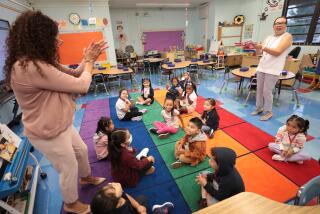Parochial School Enrollment Dwindling
- Share via
Roman Catholic elementary schools, struggling to remain affordable in the face of declining enrollments, continue to win respect as an alternative to American public education.
Three of four parochial school teachers are not priests or sisters, however, and 10% of the students are not Catholic.
The contrast is even greater for Catholic secondary schools: Only 23% of the teachers are priests, brothers or sisters (compared to 69% in 1962); 11% of the students are non-Catholic, and nearly 18% belong to racial minorities.
Since the peak in 1965, when 5.6 million students attended the nation’s 13,400 Catholic elementary and secondary schools, the Catholic system has been shrinking steadily. This year, about 2.9 million students are enrolled in 9,000 parochial schools.
Teachers Paid Less
Although Catholic lay teachers are paid considerably less than their counterparts in most public schools, the Catholic schools’ salary expenses have risen dramatically since the days when the majority of their teachers were nuns and brothers. Lay personnel accounted for a mere 8% of Catholic parochial school teachers in 1944, but since 1971 they have increasingly outnumbered religious teachers.
Parochial schools spend roughly half as much per pupil as do public schools. But the Catholic schools maintain a lower student-teacher ratio and most offer a good education.
A 1982 report by sociologist James Coleman showed that students in parochial elementary schools scored about two grade levels higher than did those in public schools in mathematics, reading and vocabulary.
The nation’s 1,464 Catholic high schools, with about 800,000 students, “are making a tremendous contribution” to quality education, according to the newest study, “The Catholic High School: A National Portrait,” released in March. About 83% of Catholic high school graduates go to college, the report said, compared with 52% of all graduates.
Few Have Deficits
Tuition, averaging $1,230 a year, covers only two-thirds of the high schools’ expenses. Still, less than 30% ran deficits in 1982-83, according to a study by the National Catholic Educational Assn.
Enrollments in 1984 at the nation’s 239 Catholic colleges and universities--one more than the year before--were up nearly 17,000, to 560,835.
Father Thomas P. O’Malley, president of the 3,500-student Jesuit-run John Carroll University in Cleveland, points to the increasing number of lay faculty members at Catholic colleges and seminaries as a trend of the 1980s.
Collaboration with faculty members of “sympathetic views of a transcendent God,” but not necessarily Roman Catholic faith, is part of an “ecumenical diversity” that O’Malley sees at Catholic universities, which he calls the “intellectual outposts” of the future.
Subject of Debate
Financial strains threaten the well-being of the Catholic school system at all levels, however, and Catholic educators say that the only answer is tuition tax credits, a view supported by the Reagan Administration and the subject of long debate in Congress this decade.
Opponents of the measure, like the American Federation of Teachers and groups concerned about the separation of church and state, argue that the government should increase its aid to public, rather than private, schools.
CATHOLIC SCHOOLS IN LOS ANGELES COUNTY LAY VS. RELIGIOUS TEACHERS
Year 1965 1970 1975 1980 1984 Lay teachers 989 1,533 1,572 1,711 1,845 Religious teachers 1,581 1,177 878 677 531
SOURCE: Los Angeles Archdiocese Dept. of Education
More to Read
Sign up for Essential California
The most important California stories and recommendations in your inbox every morning.
You may occasionally receive promotional content from the Los Angeles Times.













